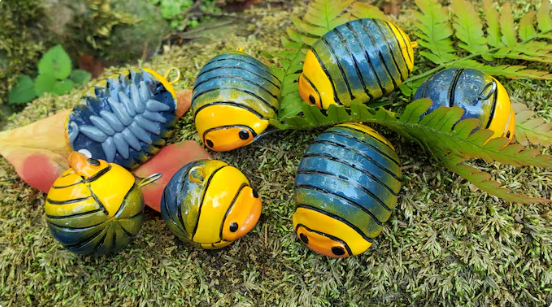The Rubber Ducky Isopod, scientifically known as Cubaris sp., is a captivating species that has garnered significant attention among enthusiasts and collectors alike. This unique isopod, discovered in the limestone caves of Thailand in 2017, stands out not only for its striking appearance but also for its intriguing behaviors and care requirements. In this article, we will delve into the fascinating world of the Rubber Ducky Isopod, exploring its characteristics, habitat needs, diet, and the reasons behind its rising popularity.
Discovery and Characteristics
The Rubber Ducky Isopod was first identified in the humid and dark environments of Thailand’s limestone caves. Its name derives from its remarkable resemblance to a rubber duck, particularly its yellow coloration and the shape of its head, which resembles a duckling’s bill. This resemblance has led to its nickname as a “designer isopod,” appealing to both casual observers and serious collectors.
Taxonomy
The Rubber Ducky Isopod belongs to the following taxonomic classification:
- Kingdom: Animalia
- Phylum: Arthropoda
- Subphylum: Crustacea
- Class: Malacostraca
- Order: Isopoda
- Family: Armadillidae
- Genus: Cubaris
This classification places it within the broader group of isopods, which are crustaceans that can be found in various habitats around the world.
Physical Characteristics
Rubber Ducky Isopods are relatively small, typically measuring around 1 to 2 centimeters in length. Their body is segmented with a hard exoskeleton that provides protection. The most distinctive feature is their coloration—bright yellow with darker markings—which mimics the appearance of a rubber duck. This unique look has made them highly sought after in the pet trade.
Habitat Requirements
Creating an ideal habitat for Rubber Ducky Isopods is crucial for their health and well-being. These creatures thrive in moist environments that closely resemble their natural habitat in damp forests and caves.
Enclosure Setup
When setting up an enclosure for Rubber Ducky Isopods, consider the following elements:
- Size: A minimum of a 10-gallon terrarium or plastic container is recommended to provide ample space for movement and exploration.
- Substrate: A mixture of coconut fiber, sphagnum moss, and leaf litter creates a rich substrate that retains moisture while providing hiding spots. This substrate should be at least 3 inches deep to allow for burrowing.
- Humidity: Maintaining high humidity levels (around 70-80%) is essential. Regular misting with dechlorinated water can help achieve this humidity without causing mold growth.
- Ventilation: Proper ventilation is necessary to prevent stagnant air, which can lead to mold or fungal growth. Small holes can be drilled into the enclosure lid or screen tops can be used to allow for airflow.
- Temperature: Rubber Ducky Isopods prefer temperatures between 70°F and 82°F (21°C to 28°C). A heat mat or low-wattage heat lamp can help maintain these temperatures if necessary.
Diet and Feeding
Rubber Ducky Isopods are detritivores, meaning they primarily feed on decaying organic matter. Their diet should mimic what they would naturally consume in the wild.
Feeding Guidelines
- Primary Diet: Offer a variety of decaying plant materials such as leaf litter and rotting wood as their main food source.
- Supplemental Foods: Include vegetable scraps like cucumber and sweet potatoes for additional nutrition. Occasional protein sources such as fish flakes or crushed insects can also be beneficial.
- Calcium Sources: Providing calcium-rich foods like cuttlebone or crushed eggshells is crucial for their exoskeleton development.
- Feeding Frequency: Food should be provided regularly but not excessively; uneaten food should be removed to prevent mold growth.
Behavior and Social Structure
Rubber Ducky Isopods are known for their shy nature, often burrowing into substrate or hiding among leaf litter when disturbed. However, as their population increases within an enclosure, they tend to become bolder and more visible.
Breeding
Breeding Rubber Ducky Isopods requires patience as they reproduce slowly compared to other species. To encourage breeding:
- Ensure optimal habitat conditions (humidity, temperature).
- Provide adequate hiding spots within the enclosure.
- Maintain a balanced diet rich in nutrients.
Popularity Among Collectors
The discovery of the Rubber Ducky Isopod has sparked a surge in interest among collectors and hobbyists. Several factors contribute to this popularity:
- Unique Appearance: Their striking resemblance to rubber ducks makes them visually appealing.
- Collectibility: As a relatively new species with limited availability, they have become a desirable addition to many collections.
- Educational Value: Keeping these isopods can offer insights into ecosystems and the role of detritivores in nature.
- Pet Potential: While they may not be traditional pets like cats or dogs, their low maintenance needs make them suitable for beginners interested in keeping exotic creatures.
Conclusion
The Rubber Ducky Isopod represents a fascinating blend of beauty and ecological importance within our planet’s diverse ecosystems. With proper care and attention to their habitat requirements, these charming creatures can thrive in captivity while providing enjoyment and education for their keepers. As interest continues to grow around this unique species, it serves as a reminder of nature’s hidden treasures waiting to be discovered and appreciated by all who seek them out. Whether you’re an experienced collector or just starting your journey into the world of isopods, the Rubber Ducky Isopod offers an engaging experience that highlights both the wonders of biodiversity and the joys of responsible pet ownership

